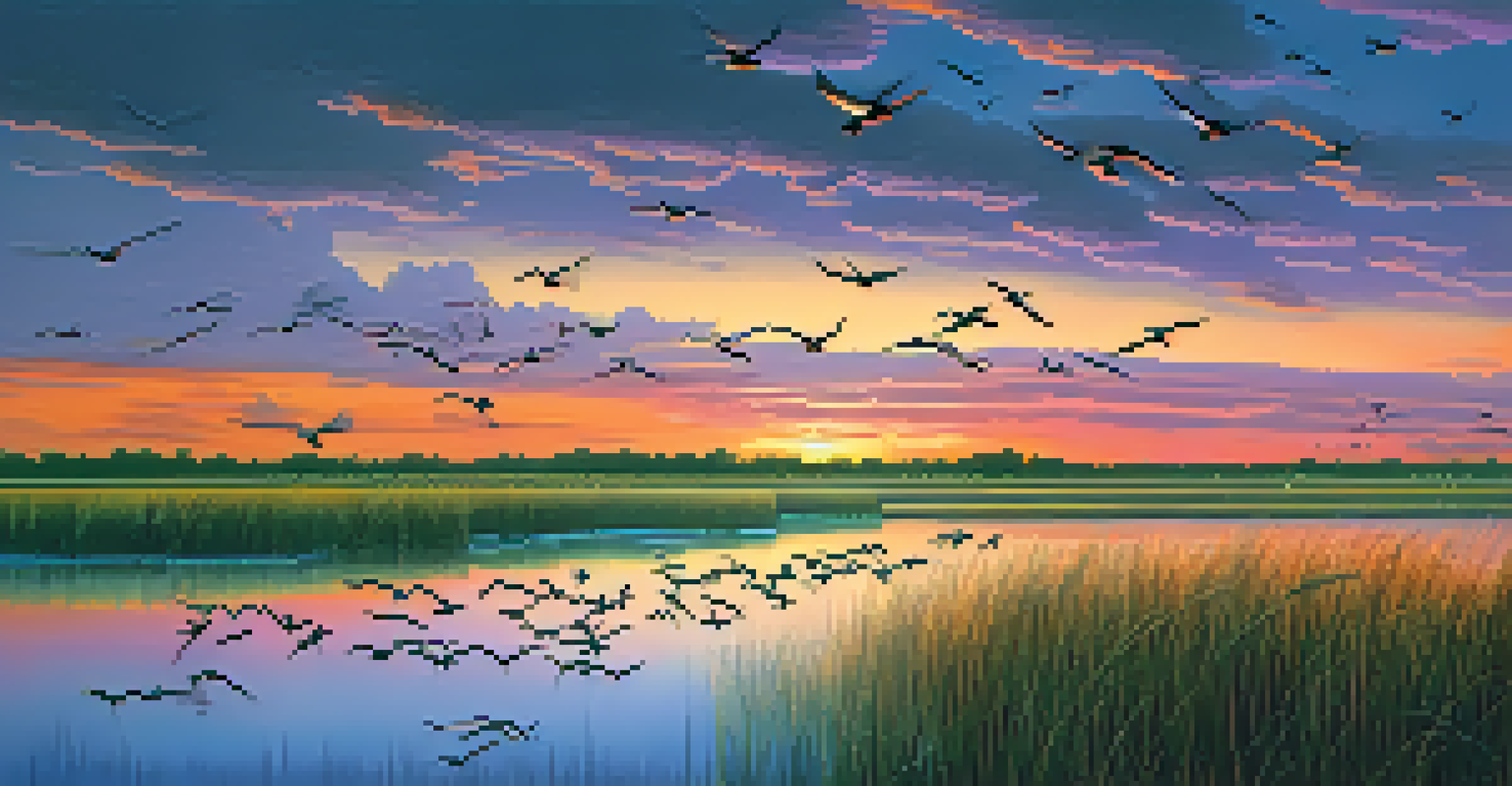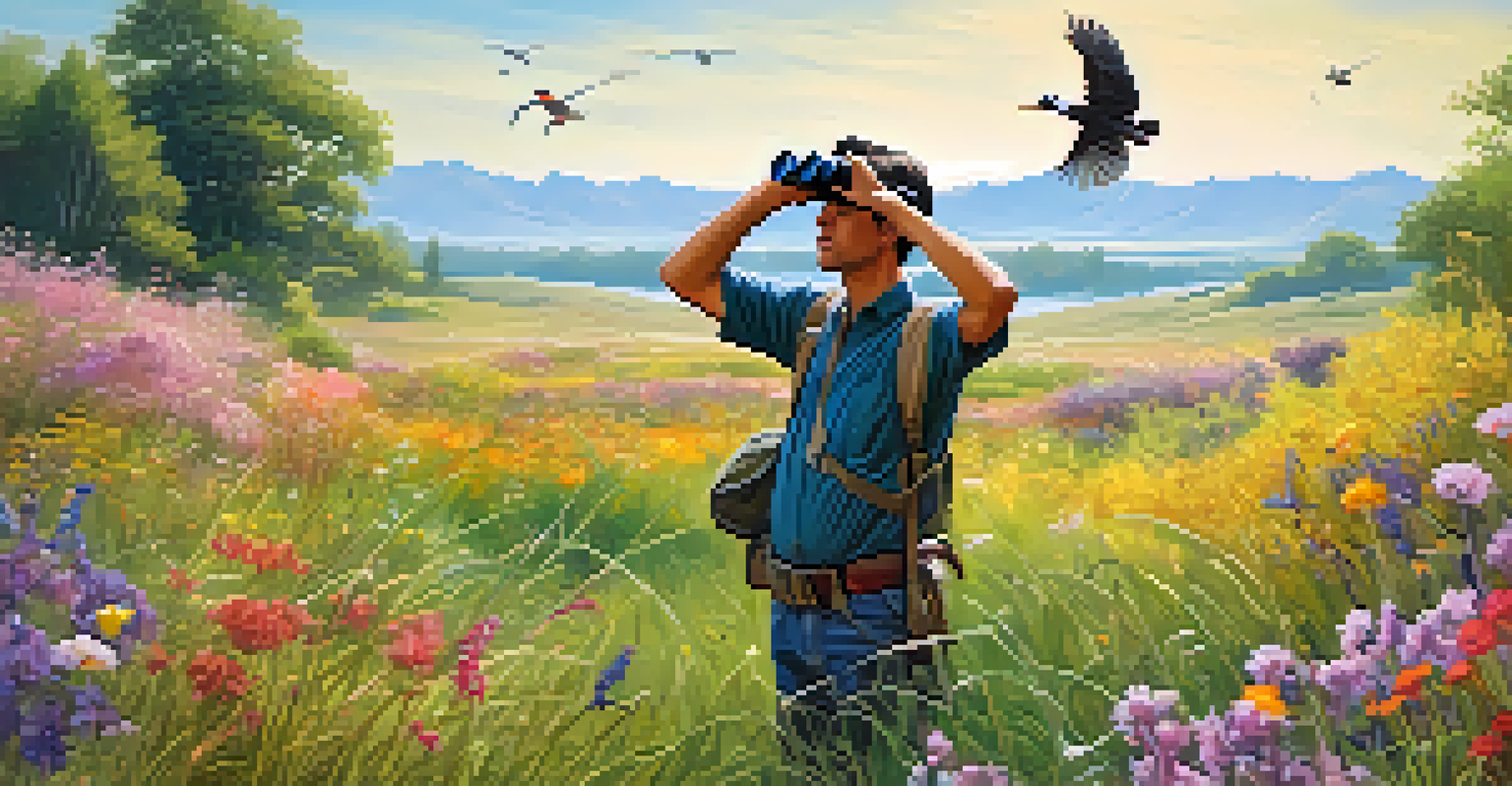Migratory Patterns: Spring Tours for Bird Watching Enthusiasts

Understanding Bird Migration: A Seasonal Journey
Bird migration is a fascinating natural phenomenon where birds travel long distances between their breeding and wintering grounds. Each spring, various species make their way back to their nesting sites, guided by instinct and environmental cues. This seasonal journey is not just about survival; it’s also a remarkable display of nature’s rhythm, marking a time of renewal and activity.
In order to see birds, it is necessary to become a part of the silence.
For bird watching enthusiasts, spring is an exciting time as it brings a wave of diverse species returning from warmer climates. From the melodious songs of warblers to the graceful flights of shorebirds, the skies are filled with life. Observing these migratory patterns allows birders to appreciate the intricate connections between wildlife and the ecosystems they inhabit.
Understanding these migratory patterns can enhance your bird watching experience. Knowing when and where to look for specific species can lead to unforgettable sightings and deepen your appreciation of avian life.
Top Spring Bird Watching Destinations in the U.S.
The United States is home to a plethora of bird watching hotspots that come alive in spring. Locations like the Everglades in Florida and Point Reyes in California attract migratory birds as they return to North America. Each region offers a unique blend of species, making it essential for birders to explore different areas during the spring season.

In the Midwest, places like the Mississippi River Flyway serve as a critical stopover for various species. Here, bird watchers can witness large flocks of waterfowl and songbirds as they pause to rest and refuel. The diversity in habitats across the country ensures that there’s something for everyone, from coastal shorelines to forested trails.
Bird Migration: A Seasonal Journey
Bird migration showcases a fascinating natural phenomenon where species travel long distances, marking a time of renewal and activity.
Planning a trip to these destinations can lead to unforgettable experiences and beautiful photographs. Whether you’re a seasoned birder or a beginner, exploring these areas during migration season can provide a thrill like no other.
Essential Gear for Bird Watching in Spring
Having the right gear can significantly enhance your bird watching experience during the spring months. Binoculars are a must-have, allowing you to get up close and personal with the feathered visitors without disturbing them. A good pair of binoculars can make all the difference in spotting elusive species perched high in the trees.
Birds are indicators of the environment. If they are in trouble, we know we’ll soon be in trouble.
In addition to binoculars, a field guide specific to your region is invaluable. This guide can help you identify birds by their appearance and songs, making it easier to track their movements. Many birders also find it helpful to bring a notebook to jot down observations, which can be a fun way to document your birding adventures.
Don’t forget to dress appropriately for the weather and consider bringing snacks and water for a comfortable outing. A well-prepared birder is a happy birder, ready to enjoy the sights and sounds of spring migration.
Timing Your Bird Watching Tours
Timing is crucial when it comes to bird watching during migration season. Generally, the best time to observe migratory birds is during the early morning when they are most active. The soft morning light not only makes for beautiful photographs but also increases your chances of spotting these birds as they forage for food.
Spring migration typically spans from late March to early June, depending on the species and region. To maximize your birding experience, consider researching peak migration times for specific birds you want to see. Many birders use apps or websites that track migration patterns to stay informed about when and where to go.
Top U.S. Bird Watching Destinations
Spring reveals numerous bird watching hotspots across the U.S., offering unique experiences and diverse species for enthusiasts.
By planning your outings around these prime times, you can ensure a more rewarding bird watching experience. Remember, patience and persistence are key traits of a successful birder!
Bird Watching Etiquette: Respecting Nature
As bird watching enthusiasts, it's essential to practice good etiquette while observing our feathered friends. This means respecting their habitats and maintaining a safe distance to avoid causing stress or disruption. Using binoculars or a camera with a zoom lens allows you to enjoy the view without encroaching on their space.
Additionally, staying on designated paths and avoiding loud noises can help protect the natural environment. Birds are sensitive to disturbances, and keeping a low profile will increase your chances of seeing them in their natural behaviors. Remember, we’re guests in their world, and our responsibility is to leave no trace.
By practicing good bird watching etiquette, we ensure that future generations can also enjoy the beauty of these migratory wonders. It’s a win-win for both birders and the birds themselves!
Capturing the Moment: Photography Tips for Birders
For many bird watchers, capturing the beauty of birds through photography is an integral part of the experience. To get started, invest in a camera with a good zoom lens, as this will allow you to take clear, detailed photos from a distance. Patience is key; often, the best shots come after waiting quietly for the perfect moment.
Consider the lighting when planning your photography outings. Early morning and late afternoon provide the best natural light, which enhances the colors and details of the birds. Experimenting with different angles and compositions can also lead to unique and stunning images.
Gear Up for Spring Bird Watching
Having the right gear, such as binoculars and field guides, significantly enhances the bird watching experience during migration.
Lastly, remember to enjoy the moment. While capturing the perfect shot is rewarding, witnessing the beauty of birds in their natural environment is an experience that can’t be replicated through a lens.
Joining a Community of Bird Watching Enthusiasts
One of the best aspects of bird watching is the community that surrounds it. Connecting with fellow birders can enhance your experience by providing opportunities to share tips, locations, and stories. Many communities host bird watching events or local meetups, which can be a great way to learn from more experienced birders.
Joining online forums or social media groups dedicated to bird watching can also provide valuable resources and camaraderie. Sharing your sightings and photos can foster connections and even inspire others to take up this rewarding hobby. Plus, it’s a fantastic way to stay updated on local migration patterns and events.

Embracing the community aspect of bird watching not only enriches your experience but also helps promote conservation efforts. Together, we can work towards protecting the habitats that our avian friends rely on.